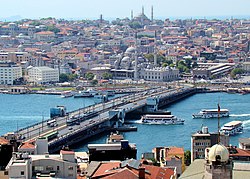Galata Bridge
|
Galata Bridge Galata Köprüsü |
|
|---|---|

|
|
| Coordinates | 41°01′12″N 28°58′23″E / 41.02000°N 28.97306°ECoordinates: 41°01′12″N 28°58′23″E / 41.02000°N 28.97306°E |
| Carries | 3 vehicular lanes, |
| Crosses | Golden Horn |
| Locale | Karaköy–Eminönü, Istanbul, Turkey |
| Owner | Metropolitan Municipality of Istanbul |
| Characteristics | |
| Design | Bascule bridge |
| Material | Steel |
| Total length | 490 m (1,610 ft) |
| Width | 42 m (138 ft) |
| Longest span | 80 m (260 ft) |
| History | |
| Designer | GAMB (Göncer Ayalp Engineering Co.) |
| Engineering design by | STFA Construction Co. |
| Construction end | December 1994 |
| Replaces | Fourth bridge (1912-1992) Third bridge (1875-1912) Second bridge (1863-1875) Cisr-i Cedid (1845-1863) |
The Galata Bridge (Turkish: Galata Köprüsü, Turkish pronunciation: [ˈɡaɫaˌta cøpryˈsy]) is a bridge that spans the Golden Horn in Istanbul, Turkey. From the end of the 19th century in particular, the bridge has featured in Turkish literature, theater, poetry and novels.
The first recorded bridge over the Golden Horn in Istanbul was built during the reign of Justinian the Great in the 6th century, close to the area near the Theodosian Land Walls at the western end of the city.
In 1453, during the Fall of Constantinople, the Turks assembled a mobile bridge by placing their ships side by side across the water, so that their troops could move from one side of the Golden Horn to the other.
In the years 1502–1503, there were plans to construct the first bridge at the current location. Sultan Bayezid II solicited a design and Leonardo da Vinci, utilizing three well-known geometrical principles, the pressed-bow, parabolic curve and keystone arch, created an unprecedented single span 240 m long and 24 m wide bridge for the Golden Horn, which would have become the longest bridge in the world of that time, had it been constructed. However, the ambitious design was not approved by the Sultan.
A smaller-scale version of Leonardo da Vinci's Golden Horn Bridge was brought to life in 2001 near Oslo, Norway by the contemporary artist Vebjørn Sand, the first civil engineering project based on a Leonardo da Vinci sketch to be constructed. The Leonardo Bridge Project hopes to build the design as a practical footbridge around the world, including the Golden Horn in Istanbul, using local materials and collaborating with local artisans as a global public art project. The Wall Street Journal referred to the Project as a "...logo for the nations."
...
Wikipedia
